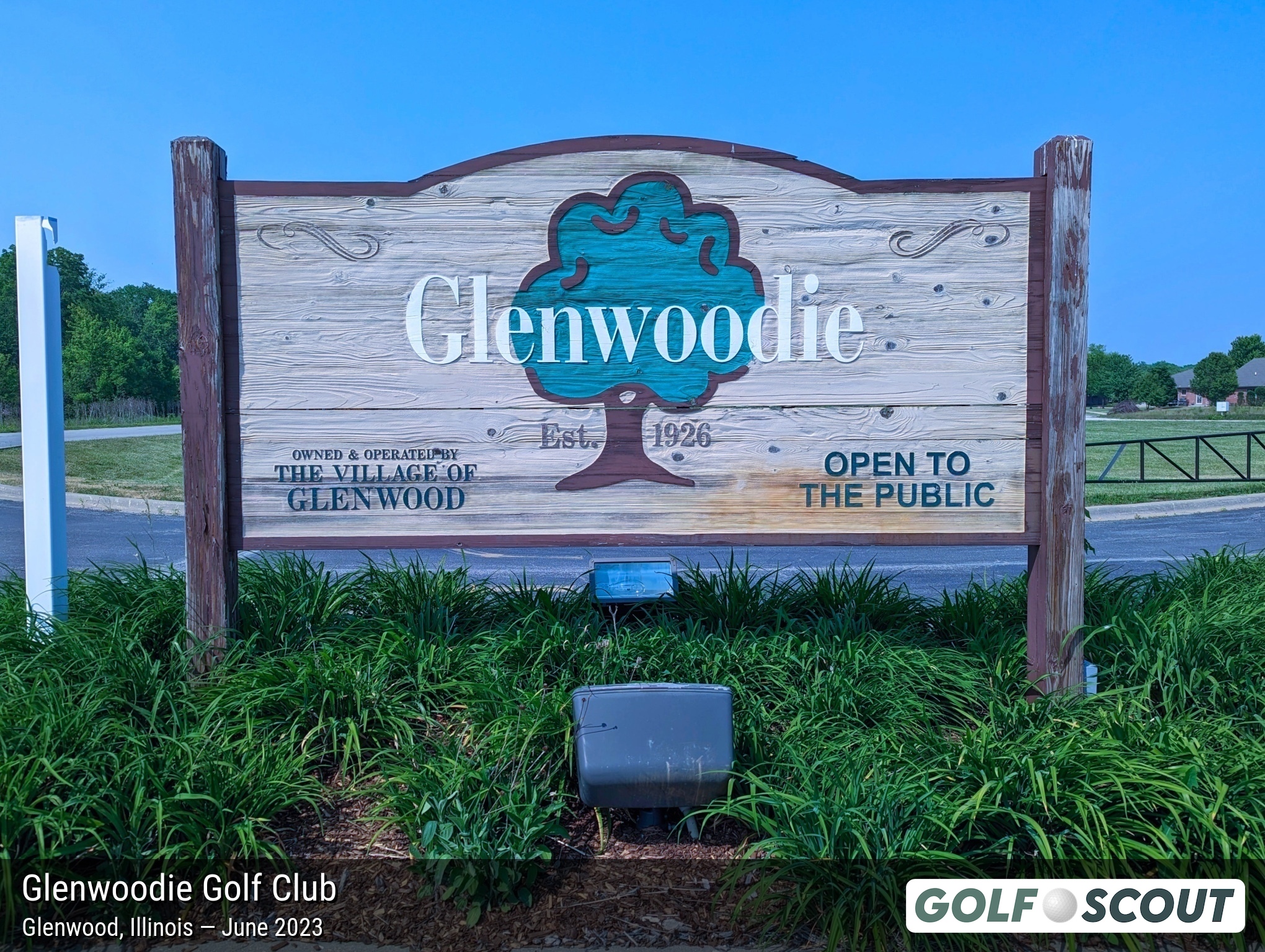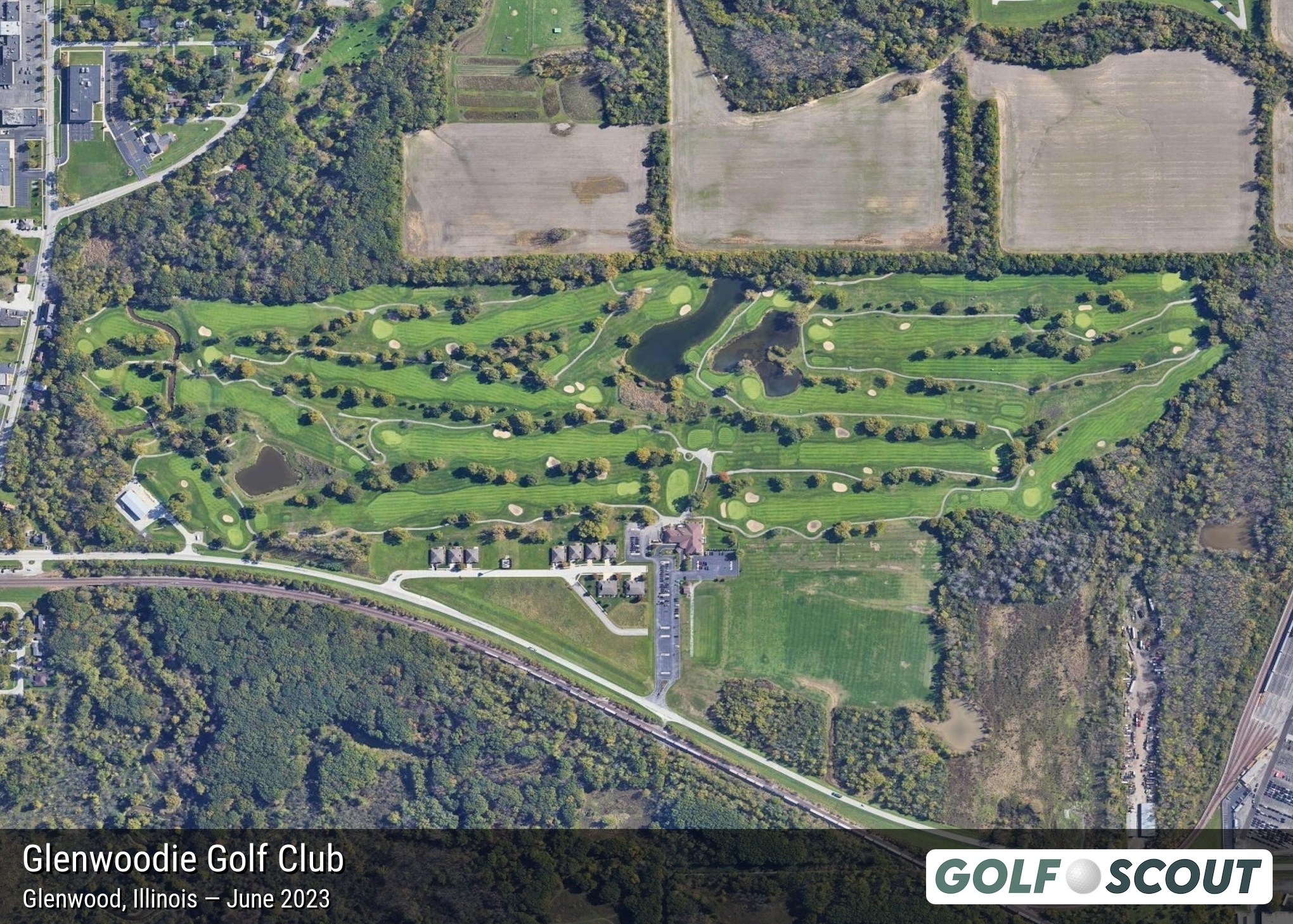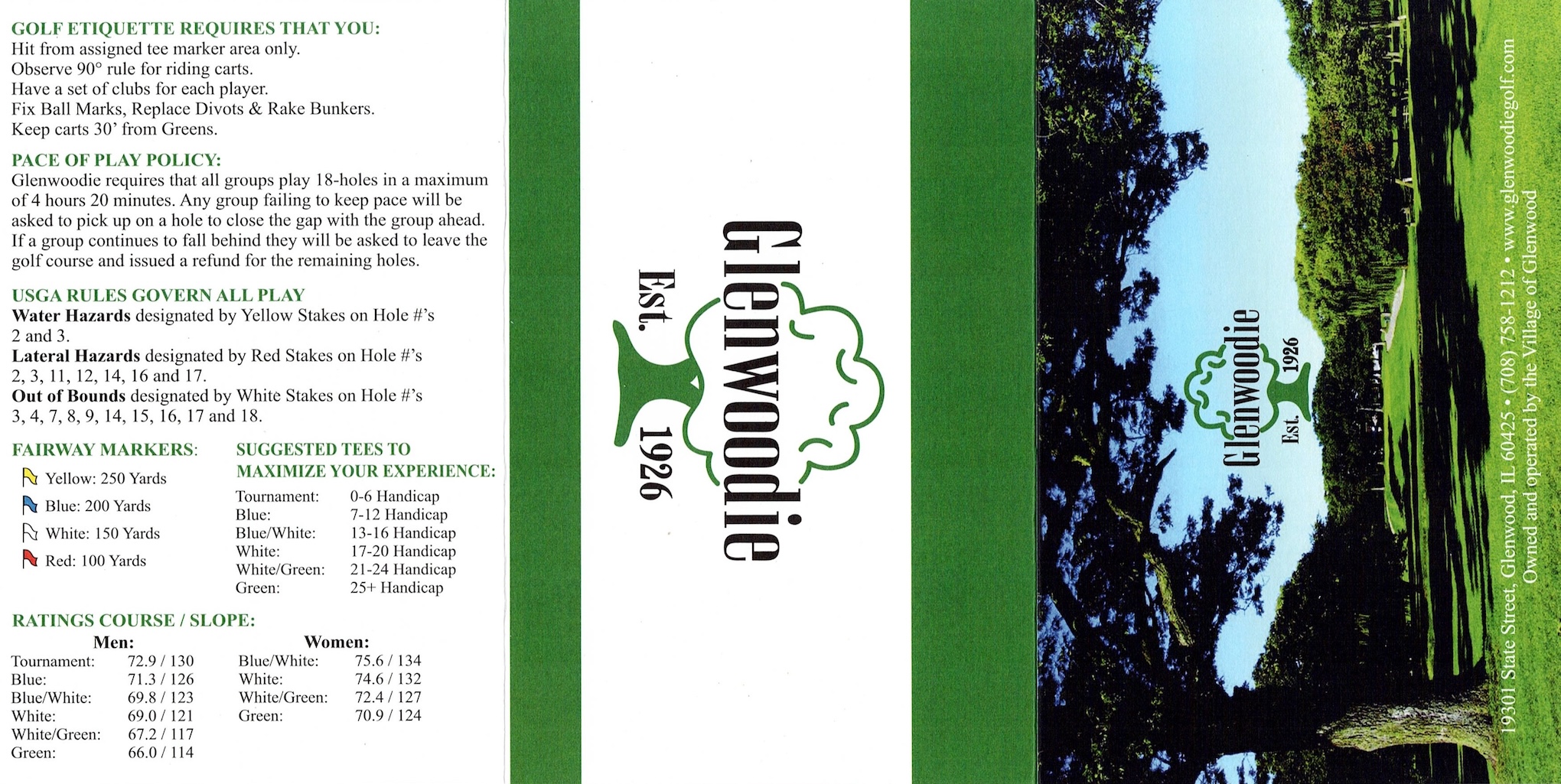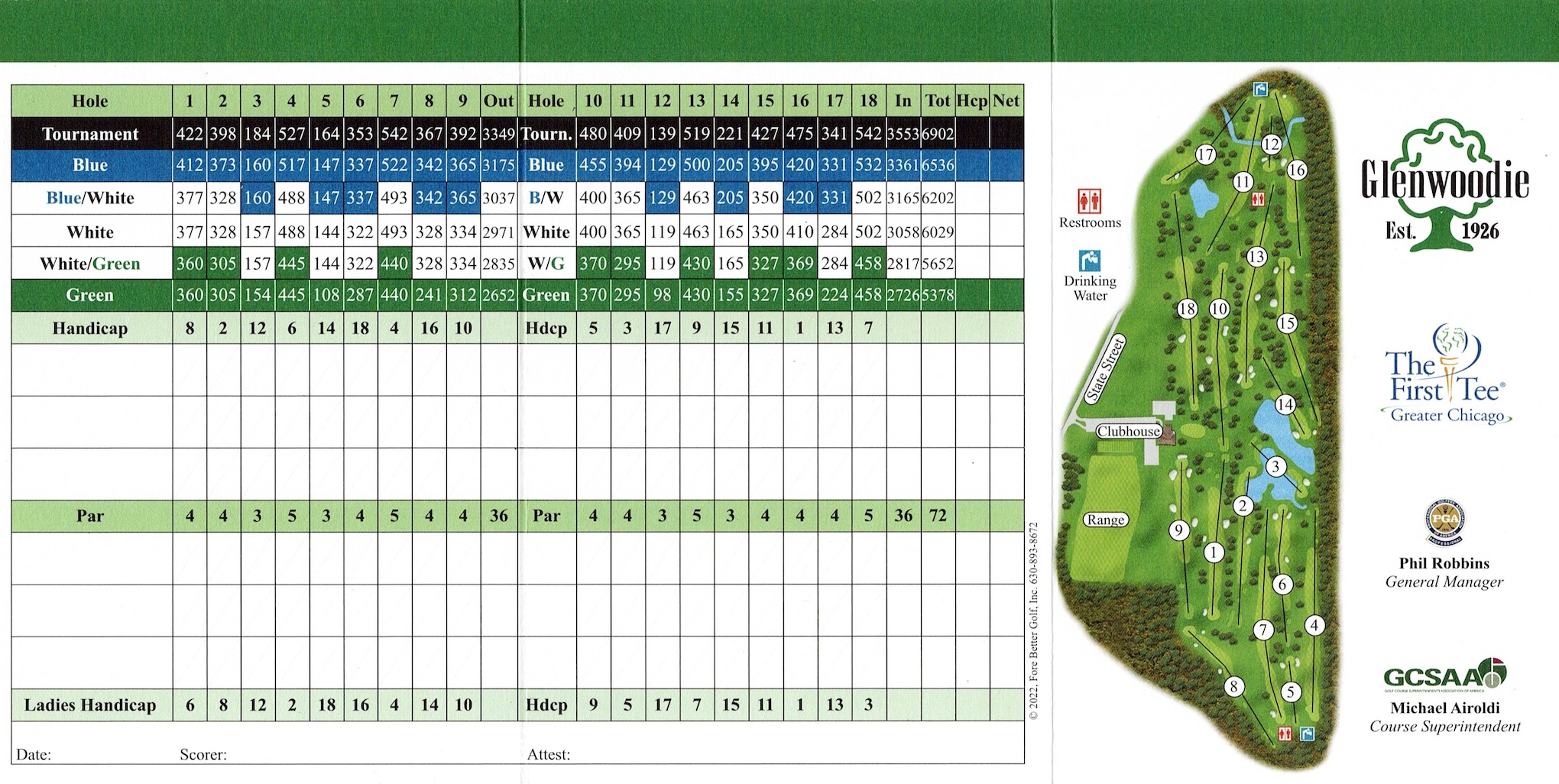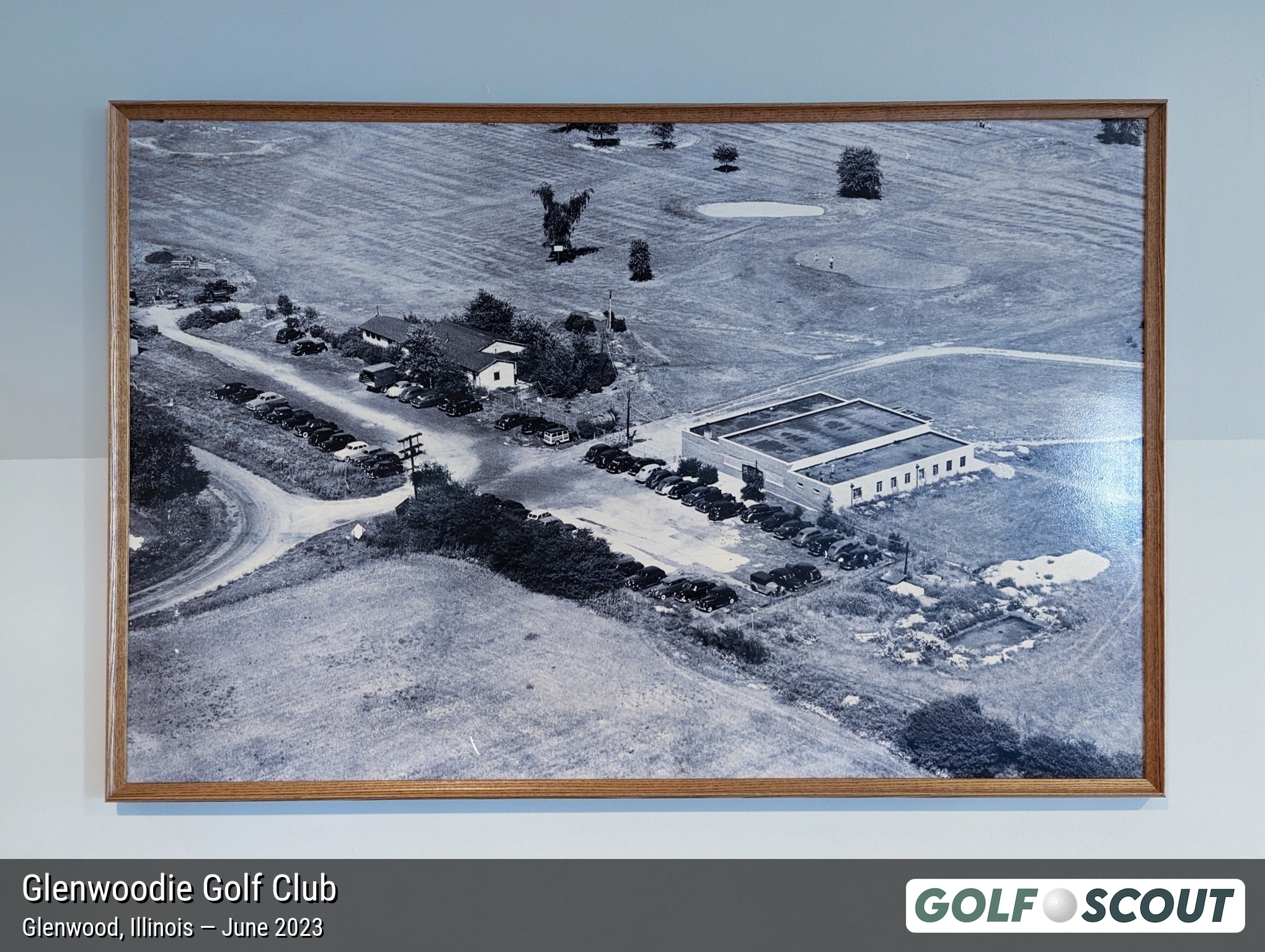Glenwoodie Golf Club
Glenwood, Illinois
| Course Type | Public - 18 holes | |
| ’25 Max Green Fee | $56 + $20 for cart | |
| Par & Tees | 72 (36/36) - 4 tees | |
| Course Length | 6902 yards | |
| Longest Hole | 542 yards | |
| Rating & Slope | 72.9/130 (M) | |
| Driving Range | Yes | |
| Year Built | 1926 | |
| Tee Time Spacing | 10 minutes 🙂 New! |
Glenwoodie Golf Club Overview
Updated June 9, 2025
Glenwoodie Golf Club carries nearly a century of golf history in the far south suburbs of Glenwood, Illinois. This historic 18-hole layout began modestly in 1926 with just two holes, expanded to nine in 1927, and eventually grew into the full championship course golfers enjoy today. An August 25, 1925 Chicago Tribune article proclaimed "A new golf club for the south side has been organized. The site consists of 159 acres, is rolling and well wooded, and has a wide creek running through it." The ambitious project came with a hefty price tag of $159,000 for the land purchase alone.
The course was designed by architect Harry Collis, a member of the Illinois PGA Golf Hall of Fame who also served as head professional and greenskeeper. Collis brought considerable experience to the project, having served in a similar capacity at Flossmoor for 22 years prior. Like many courses of its era, Glenwoodie weathered difficult times during World War II and was sold at auction in December 1946 after falling heavily in debt. After passing through several owners, the property was purchased by the Roman Catholic Archdiocese of Chicago. In 1958, legendary golf entrepreneur Joe Jemsek leased the course from the Archdiocese. This Illinois Golf Hall of Famer, who also operated Cog Hill, St. Andrews, and Fresh Meadow, brought his expertise to Glenwoodie's operations. The Village of Glenwood ultimately purchased the course from the Archdiocese in 1995 for approximately $4.2 million.
At 6,902 yards with a course rating of 72.9 and slope of 130, Glenwoodie presents a challenge comparable in difficulty to courses like Water's Edge, Deerfield, and Springbrook. The layout features standard par-72 scoring with two par-5s and two par-3s per nine holes. Deer Creek winds through the northern portion of the property, affecting play on four holes, while three additional ponds demand attention throughout the round. The front nine occupies the southern section of the real estate with narrow fairways that create a slightly claustrophobic feel among parallel holes separated by scattered trees. The back nine proves far more memorable and challenging, with generations-old rumors suggesting the original club built this section first before running short on funds for the front nine construction.
The course's signature challenge comes at the 475-yard 16th hole, widely regarded as one of Chicagoland's most difficult par-4s. This beast features a narrow landing zone with Deer Creek cutting through the final approach in a deep ravine. Position your drive too far left and trees block access to the diminutive, elevated green that feels like it's protected by 2-factor authentication. Stray too far right and you're out of bounds. Good luck!
Glenwoodie underwent a major $3 million transformation in 2011, unveiling a stately 14,000-square-foot clubhouse alongside comprehensive course improvements. The modern facility features a well-stocked pro shop with Glenwoodie-branded merchandise if you feel like repping this place, a wide grass driving range visible upon arrival, and a large practice green situated behind the clubhouse. The restaurant area includes a 12-seat bar, and the facility also offers slot machine gaming (if that’s your thing) and hosts events and weddings.
With 10-minute tee time intervals and walkable terrain featuring rolling hills, Glenwoodie offers solid conditioning typical of reasonably priced municipal courses, though perfection shouldn't be expected. The course even boasts a connection to golf royalty; Tiger Woods and his father Earl played here in 1994 after Tiger missed the cut as an amateur at the Western Open, documented in 2017 by golf writer Tim Cronin of Chicago District Golfer magazine.
Updated June 9, 2025
Glenwoodie Golf Club carries nearly a century of golf history in the far south suburbs of Glenwood, Illinois. This historic 18-hole layout began modestly in 1926 with just two holes, expanded to nine in 1927, and eventually grew into the full championship course golfers enjoy today. An August 25, 1925 Chicago Tribune article proclaimed "A new golf club for the south side has been organized. The site consists of 159 acres, is rolling and well wooded, and has a wide creek running through it." The ambitious project came with a hefty price tag of $159,000 for the land purchase alone.
The course was designed by architect Harry Collis, a member of the Illinois PGA Golf Hall of Fame who also served as head professional and greenskeeper. Collis brought considerable experience to the project, having served in a similar capacity at Flossmoor for 22 years prior. Like many courses of its era, Glenwoodie weathered difficult times during World War II and was sold at auction in December 1946 after falling heavily in debt. After passing through several owners, the property was purchased by the Roman Catholic Archdiocese of Chicago. In 1958, legendary golf entrepreneur Joe Jemsek leased the course from the Archdiocese. This Illinois Golf Hall of Famer, who also operated Cog Hill, St. Andrews, and Fresh Meadow, brought his expertise to Glenwoodie's operations. The Village of Glenwood ultimately purchased the course from the Archdiocese in 1995 for approximately $4.2 million.
At 6,902 yards with a course rating of 72.9 and slope of 130, Glenwoodie presents a challenge comparable in difficulty to courses like Water's Edge, Deerfield, and Springbrook. The layout features standard par-72 scoring with two par-5s and two par-3s per nine holes. Deer Creek winds through the northern portion of the property, affecting play on four holes, while three additional ponds demand attention throughout the round. The front nine occupies the southern section of the real estate with narrow fairways that create a slightly claustrophobic feel among parallel holes separated by scattered trees. The back nine proves far more memorable and challenging, with generations-old rumors suggesting the original club built this section first before running short on funds for the front nine construction.
The course's signature challenge comes at the 475-yard 16th hole, widely regarded as one of Chicagoland's most difficult par-4s. This beast features a narrow landing zone with Deer Creek cutting through the final approach in a deep ravine. Position your drive too far left and trees block access to the diminutive, elevated green that feels like it's protected by 2-factor authentication. Stray too far right and you're out of bounds. Good luck!
Glenwoodie underwent a major $3 million transformation in 2011, unveiling a stately 14,000-square-foot clubhouse alongside comprehensive course improvements. The modern facility features a well-stocked pro shop with Glenwoodie-branded merchandise if you feel like repping this place, a wide grass driving range visible upon arrival, and a large practice green situated behind the clubhouse. The restaurant area includes a 12-seat bar, and the facility also offers slot machine gaming (if that’s your thing) and hosts events and weddings.
With 10-minute tee time intervals and walkable terrain featuring rolling hills, Glenwoodie offers solid conditioning typical of reasonably priced municipal courses, though perfection shouldn't be expected. The course even boasts a connection to golf royalty; Tiger Woods and his father Earl played here in 1994 after Tiger missed the cut as an amateur at the Western Open, documented in 2017 by golf writer Tim Cronin of Chicago District Golfer magazine.
Glenwoodie Golf Club Map & Aerial Imagery
Anetsberger Golf Course
Apple Orchard Golf Course
Arboretum Club
Arlington Lakes Golf Club
Arrowhead East Course
Arrowhead South Course
Arrowhead West Course
Balmoral Woods Golf Club
Bartlett Hills Golf Club
Belmont Golf Club
Big Run Golf Club
Billy Caldwell Golf Course
Bittersweet Golf Club
Blackberry Oaks Golf Course
Blackstone Golf Club
Bliss Creek Golf Course
Bloomingdale Golf Club
Bolingbrook Golf Club
Bonnie Brook Golf Course
Bonnie Dundee Golf Club
Boone Creek Golf Club - Creekside Course
Boone Creek Golf Club - Prairie Course
Boone Creek Golf Club - Valley Course
Boughton Ridge Golf Course
Bowes Creek Country Club
Brae Loch Golf Club
Bridges of Poplar Creek Country Club
Broken Arrow Golf Club - East Course
Broken Arrow Golf Club - North Course
Broken Arrow Golf Club - South Course
Buffalo Grove Golf Course
Burnham Woods Golf Course
Calumet Country Club
Canal Shores Golf Course
Cantigny Hillside Course
Cantigny Lakeside Course
Cantigny Woodside Course
Cardinal Creek Golf Club - Center Course
Cardinal Creek Golf Club - North Course
Cardinal Creek Golf Club - South Course
Carriage Greens Country Club
Cary Country Club
Centennial Park Golf Course
Chalet Hills Golf Club
Chapel Hill Country Club
Chevy Chase Country Club
Chicago Heights East Golf Course
Chicago Heights West Golf Course
Chick Evans Golf Course
Cog Hill Course #1
Cog Hill Course #2 - Ravines
Cog Hill Course #3
Cog Hill Course #4 - Dubsdread
Columbus Park Golf Course
Countryside Prairie Course
Countryside Traditional Course
Coyote Run Golf Course
Craig Woods Golf Club
Crane's Landing Golf Club
Crystal Woods Golf Club
Deer Creek Golf Club
Deerfield Golf Club & Learning Center
Deerpath Golf Course
Eaglewood Resort Golf Club
Edgebrook Golf Course
Flagg Creek Golf Course
Foss Park Golf Course
Fountain Hills Golf Club
Fox Bend Golf Course
Fox Lake Country Club
Fox Run Golf Links
Foxford Hills Golf Club
Fresh Meadow Golf Club (Closed)
George W. Dunne National
Glencoe Golf Club
Glendale Lakes Golf Club
Glenview Park Golf Club
Glenview Prairie Club
Glenwoodie Golf Club
Golf Center Des Plaines
Golf Club of Illinois
Golf Vista Estates Golf Course
Grayslake Golf Course
Green Garden Blue Course
Green Garden Gold Course
Green Garden Links Course
Green Meadows Golf Course
Greenshire Golf Course
Harborside International - Port Course
Harborside International - Starboard Course
HeatherRidge Golf Course
Heritage Oaks Golf Club - Classic 18
Hickory Hills Country Club
Hickory Knoll Golf Course
Highland Woods Golf Course
Highlands of Elgin Golf Course
Hilldale Golf Club
Hughes Creek Golf Club
Indian Boundary Golf Course
Inwood Golf Course
Jackson Park Golf Course
Joe Louis “The Champ” Golf Course
Klein Creek Golf Club
Lake Bluff Golf Club
Lake Park Golf Course
Lincoln Oaks Golf Course
Links at Carillon - Blue Course
Links at Carillon - Red Course
Links at Carillon - White Course
Lombard Golf Course
Lost Marsh Golf Course
Makray Memorial Golf Club
Maple Meadows Golf Course
Marengo Ridge Golf Club
Marquette Park Golf Course
Meadowlark Golf Course
Meadows Golf Club of Blue Island
Midlane Country Club
Mill Creek Golf Club
Mistwood Golf Club
Mt. Prospect Golf Club
Naperbrook Golf Course
Nickol Knoll Golf Club
Oak Brook Golf Club
Oak Grove Golf Course
Oak Hills Country Club
Odyssey Golf Foundation
Old Oak Country Club
Old Orchard Country Club
Old Top Farm Golf Course
Orchard Valley Golf Course
Palatine Hills Golf Course
Palmira Golf Club
Palos Country Club
Palos Hills Golf Club
Phillips Park Golf Course
Pine Meadow Golf Club
Pinecrest Golf Club
Pistakee Country Club
Pottawatomie Golf Course
Prairie Bluff Golf Club
Prairie Isle Golf Course
Prairie Landing Golf Club
Randall Oaks Golf Club
Ravisloe Country Club
RedTail Golf Club
Renwood Golf Course
River Bend Golf Club
River Oaks Golf Course
Rob Roy Golf Course
Robert A. Black Golf Course
Ruffled Feathers Golf Club
Salt Creek Golf Club
Sanctuary Golf Course
Schaumburg Golf Club - Baer Course
Schaumburg Golf Club - Players Course
Schaumburg Golf Club - Tournament Course
Settler's Hill Golf Course
Seven Bridges Golf Club
Shepherd's Crook Golf Course
Shiloh Park Golf Course
Silver Lake North Course
Silver Lake Rolling Hills Course
Silver Lake South Course
South Shore Golf Course
Springbrook Golf Course
Square Links Golf Course
St. Andrews - Joe Jemsek Course
St. Andrews - St. Andrews Course
Steeple Chase Golf Club
Stonewall Orchard Golf Club
Stony Creek Golf Course
Streamwood Oaks Golf Club
Sugar Creek Golf Course
Sunset Valley Golf Club
Sydney R. Marovitz Golf Course
Tam O'Shanter Golf Course
Tamarack Golf Club
Tanna Farms Golf Club
The Glen Club
The Preserve at Oak Meadows
Thunderhawk Golf Club
Tuckaway Golf Club
Turnberry Golf Club
Twin Lakes Golf Club
Twin Lakes Golf Course
University Park Golf Club
Valley Ridge Golf Course
Vernon Hills Golf Course
Veterans Memorial Golf Course
Villa Olivia Golf Course
Village Green Golf Course
Village Greens of Woodridge
Village Links of Glen Ellyn - 18 Hole Course
Village Links of Glen Ellyn - 9 Hole Course
Water’s Edge Golf Club
Wedgewood Golf Course
Whisper Creek Golf Club
White Deer Run Golf Club
White Mountain Golf Park
White Pines East Course
White Pines West Course
Whitetail Ridge Golf Club
Wicker Memorial Park Golf Course
Willow Crest Golf Club
Willow Hill Golf Course
Wilmette Golf Club
Wing Park Golf Course
Winnetka Golf Club
Woodruff Golf Course
Zigfield Troy Golf

